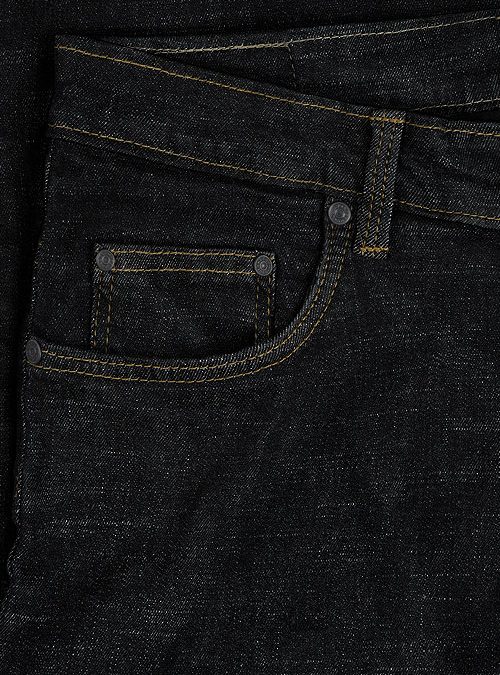When shopping for jeans, you’ll probably encounter a myriad of terms. You can’t expect to choose the perfect jeans, of course, unless you understand what these terms mean. Different manufacturers use different specifications to describe their jeans. By familiarizing yourself with the following denim-related terms, you’ll have an easier time choosing the perfect jeans that match your personal style and preference.
Rivets
Regardless of the brand, most jeans are made with rivets. Rivets are button-like fasteners that are used to secure seams. You can usually find them around the pockets and the fly. Jeans still have buttons, but most of them have rivets as well. Rivets are designed to hold the seams together, resulting in longer-lasting jeans that are better protected from premature wear and tear.
Preshrunk
Some jeans are preshrunk. As the name suggests, preshrunk jeans are intentionally shrunk during production. Jeans are made of denim. When exposed to water for the first time, new denim will typically shrink. Therefore, some jeans are intentionally shrunk during production. Manufacturers submerge them in water so that they shrink. Doing so will then protect the jeans from future shrinkage. Preshrunk jeans have become increasingly common, and you can find them in dozens of different styles.
Stretch Denim
You may discover that some jeans are made of stretch denim. Stretch denim jeans look like most other types of jeans; they are even available in the same styles. Stretch denim, however, isn’t the same as traditional denim. Traditional denim is pure denim that’s made entirely of cotton. Stretch denim, on the other hand, is a hybrid material that consists primarily of denim with a small amount of an elastic fabric. Stretch denim may contain lycra or polyester. When mixed with denim, elastic fabrics like lycra or polyester increase its elasticity.
Raw Denim
In addition to stretch denim, some jeans are made of raw denim. Upon hearing the term “raw denim,” you may assume that it’s the same as plain, pure denim — but this isn’t the case. Raw denim is defined as any denim that isn’t washed during production. It’s also known as unwashed denim. Some people prefer jeans made of raw or unwashed denim because they tend to feature a darker color than those made of washed denim.
Boot Cut
Boot cut is a particular style of jeans that’s designed for use with boots. You can find boot-cut jeans in preshrunk, stretch and raw denim. If you inspect the bottom of boot-cut jeans, you’ll notice they are tapered. The bottom of each pant leg becomes wider towards the bottom. This tapered design allows you to fit them over the top of your boots. You can wear other types of jeans with boots. Boot-cut jeans are simply ideal for boots because of their tapered design.
Acid Wash
Another common denim term you need to know is acid wash. What is acid wash exactly? Acid wash refers to a specific distressing process in which denim is exposed to chemicals that cause discoloration. The denim is first dyed, after which it’s used to make a new pair of jeans. The jeans, however, are then exposed to chemicals like phenol, caustic soda or acid, which causes discoloration. Acid-wash jeans have been around for decades. They are characterized by discoloration in specific areas.

Sandblasting
Acid washing is just one of several distressing processes for jeans. There’s also sandblasting. Sandblasting lives up to its namesake by literally blasting the surface of jeans with particles of sand. It’s used to create distressed jeans. When blasted with sand, the jeans will wear down in the areas where they are exposed to the sand particles. Sandblasting doesn’t result in discoloration like acid washing. Instead, it simply degrades the surface of denim to achieve a naturally worn-in and aged appearance.
Whiskers
You may find that some jeans feature whiskers. Whiskers are marks or patterns of fading. Manufacturers add them to jeans to create a unique appearance. Whiskers typically consist of several horizontal lines they gradually become closer to each other in the center. This design mimics the whiskers of a cat. Most jeans have clean denim that is devoid of whiskers. Nonetheless, if you’re looking for a unique appearance, you may want to choose jeans with whiskers.
There are different types of whiskers. While most of them resemble the whiskers of a cat, some of them feature alternative shapes and designs. Train track whiskers, for example, resemble train tracks, whereas honeycomb whiskers resemble honeycombs. Regardless, they are all marks or patterns of fading that are created when the jeans are originally produced.
Rise
The term “rise” refers to where a pair of jeans sit on the waist when worn. While most jeans sit directly around the middle of the waist when worn, this doesn’t apply to all of them. Some jeans sit 1 or 2 inches below the waist when worn. Others sit 1 or 2 inches above the waist when worn. The former type are known as low-rise jeans, whereas the latter type are known as high-rise jeans.
Cropped
Not all jeans extend to the ankles or feet when worn. Some of them are designed in a shorter length. Known as cropped jeans, they typically extend a few inches below the knees. Cropped jeans aren’t full-length jeans. Cropped jeans are available in different colors, as well as cuts, but they all consist of a short length.
Pull-On Jeans
There are pull-on jeans as well. Available for sale here at MakeYourOwnJeans, pull-on jeans are exactly what they sound like: jeans that you can pull on over your legs to wear. Most jeans have a traditional fly consisting of a zipper and buttons. Pull-on jeans differ in the sense that they feature a drawstring rather than a traditional fly. You don’t have to mess with a zipper or buttons. To wear a pair of pull-on jeans, you can pull them over your jeans. Pull-on jeans are typically made of soft, lightweight denim, resulting in a super-soft texture that makes them comfortable to wear.











